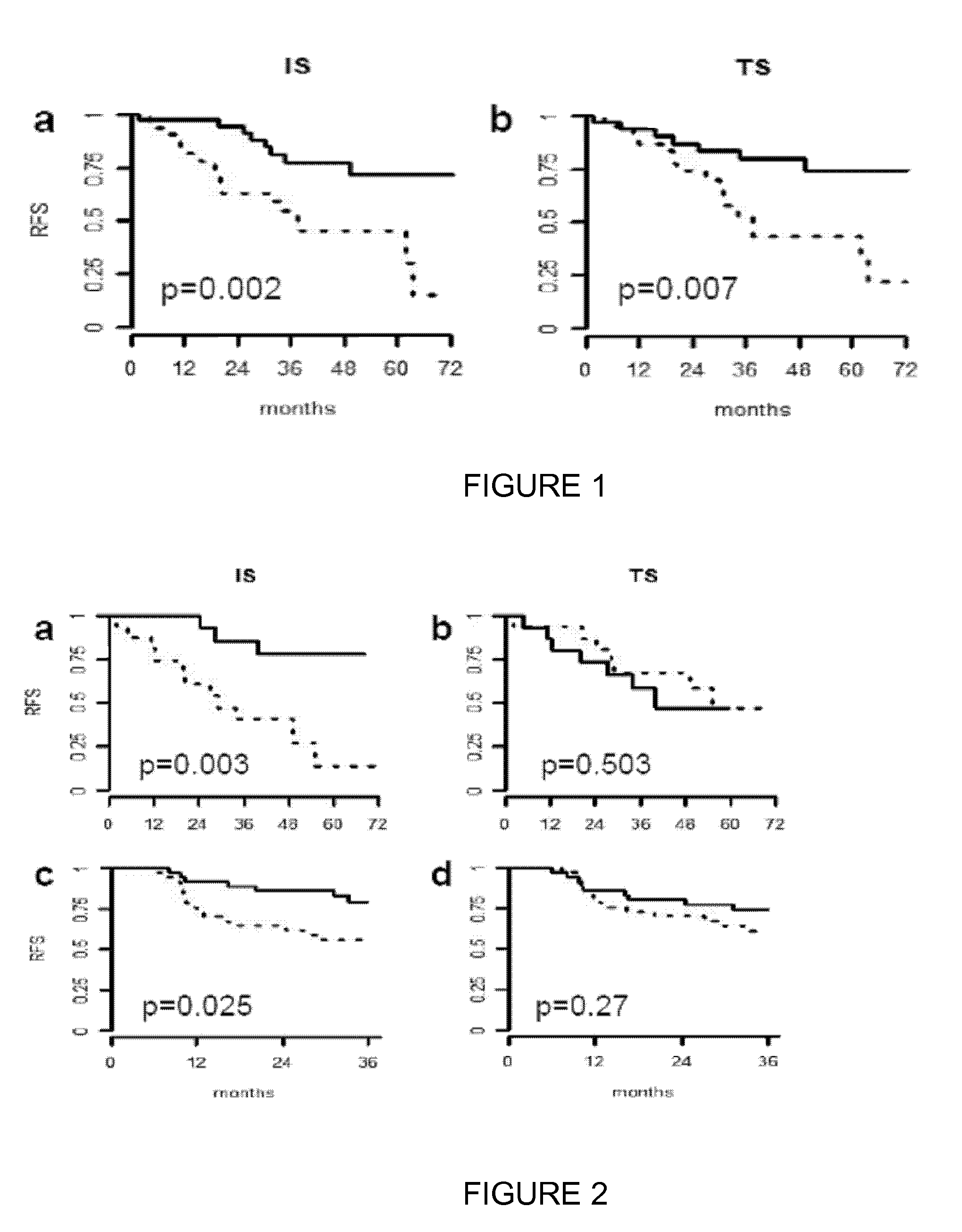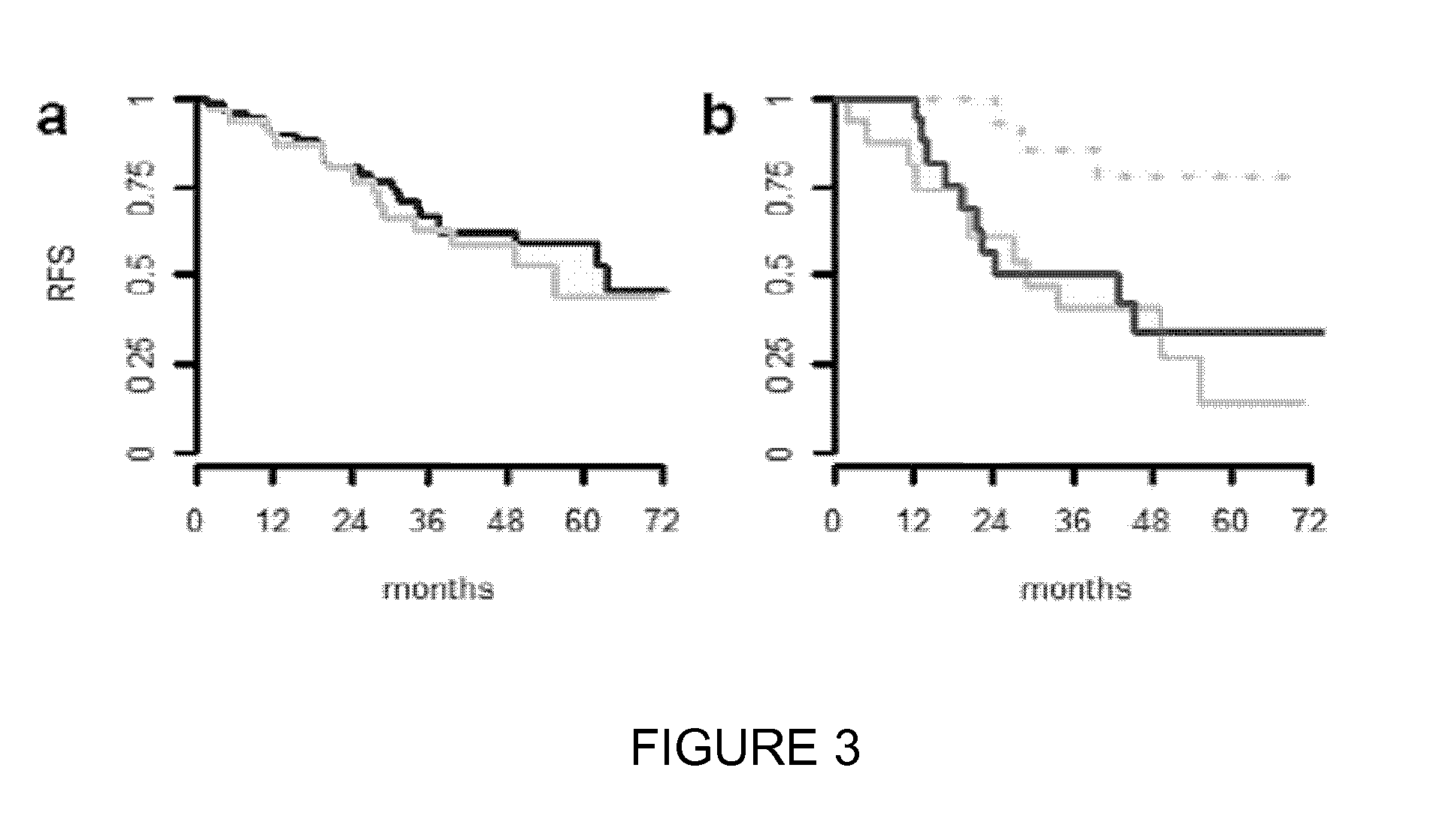Method for predicting clinical outcome of patients with non-small cell lung carcinoma
a clinical outcome technology, applied in the field of predicting clinical outcome of patients with non-small cell lung cancer, can solve the problems of high complexity of treatment choices, controversial utility of adjuvant chemotherapy for stage ib tumors, and limitations of previous studies
Inactive Publication Date: 2014-05-20
ASSISTANCE PUBLIQUE HOPITAUX DE PARIS
View PDF2 Cites 3 Cited by
- Summary
- Abstract
- Description
- Claims
- Application Information
AI Technical Summary
Benefits of technology
The patent text explains that the architecture of CNAs is complex and consists of multiple "subalterations" with varying degrees of copy number change. Not all genes within a CNA region will necessarily show altered gene expression, and some genes may be inconsequential for tumor behavior. Including such genes into a survival model may only add noise and reduce predictive accuracy. The technical effect of this patent is to improve the accuracy and predictive capacity of survival models by identifying and eliminating inconsequential genes within CNAs.
Problems solved by technology
Treatment choices are highly complex even for physicians with much experience in the field and they largely depend on the stage of the disease.
The utility of adjuvant chemotherapy for the stage IB tumors, however, remains controversial.
Although promising, these previous studies are also not without limitations.
This failure to incorporate histological subtype might reduce model robustness and predictive accuracy in the pure gene expression based models.
One major feature shared by many NSCLCs is chromosomal instability, which can result in the amplification and deletion of either specific genomic regions or even entire chromosomes.
Also, the architecture of CNAs are often complex and consist of multiple “subalterations” with varying degrees of copy number change and not all genes within a CNA region will necessarily show altered gene expression (“copy number driven expression”) (Gelsi-Boyer 2005; Pollack et al, 2002).
These observations suggest that a substantial proportion of genes within CNAs may be inconsequential for tumor behaviour, and including such genes into a survival model may only add noise and reduce predictive accuracy.
Method used
the structure of the environmentally friendly knitted fabric provided by the present invention; figure 2 Flow chart of the yarn wrapping machine for environmentally friendly knitted fabrics and storage devices; image 3 Is the parameter map of the yarn covering machine
View moreImage
Smart Image Click on the blue labels to locate them in the text.
Smart ImageViewing Examples
Examples
Experimental program
Comparison scheme
Effect test
example
Prediction of Clinical Outcome in Multiple Lung Cancer Cohorts By Integrative Genomics: Implications for Chemotherapy Selection
the structure of the environmentally friendly knitted fabric provided by the present invention; figure 2 Flow chart of the yarn wrapping machine for environmentally friendly knitted fabrics and storage devices; image 3 Is the parameter map of the yarn covering machine
Login to View More PUM
| Property | Measurement | Unit |
|---|---|---|
| endoscopic ultrasound | aaaaa | aaaaa |
| width | aaaaa | aaaaa |
| weight | aaaaa | aaaaa |
Login to View More
Abstract
The invention provides an in vitro method for predicting clinical outcome of a patient affected with a non-small cell lung carcinoma (NSCLC), which method comprises determining the expression level of at least 8 genes in a biological sample of said patient.
Description
CROSS-REFERENCE TO RELATED APPLICATION[0001]This application is the U.S. national stage application of International Patent Application No. PCT / EP2009 / 058315, filed Jul. 2, 2009, which claims the benefit of U.S. Provisional Patent Application No. 61 / 077,566, filed Jul. 2, 2008, the disclosures of which are hereby incorporated by reference in their entireties, including all figures, tables and amino acid or nucleic acid sequences.[0002]The Sequence Listing for this application is labeled “Seq-List.txt” which was created on Dec. 21, 2010 and is 117 KB. The entire contents of the sequence listing is incorporated herein by reference in its entirety.[0003]The present invention relates to a method for classifying patients affected with non-small cell lung carcinoma (NSCLC), and predicting responsiveness to a chemotherapeutic treatment.[0004]Non-small cell lung carcinoma (NSCLC) is the most common cause of worldwide cancer mortality, with a global five-year survival rate of 15% for all NSC...
Claims
the structure of the environmentally friendly knitted fabric provided by the present invention; figure 2 Flow chart of the yarn wrapping machine for environmentally friendly knitted fabrics and storage devices; image 3 Is the parameter map of the yarn covering machine
Login to View More Application Information
Patent Timeline
 Login to View More
Login to View More Patent Type & Authority Patents(United States)
IPC IPC(8): C12Q1/68
CPCC12Q2600/136C12Q2600/106C12Q2600/112C12Q2600/118C12Q1/6886
Inventor BROET, PHILIPPECAMILLERI-BROET, SOPHIEMILLER, LANCETAN, PATRICK
Owner ASSISTANCE PUBLIQUE HOPITAUX DE PARIS
Features
- R&D
- Intellectual Property
- Life Sciences
- Materials
- Tech Scout
Why Patsnap Eureka
- Unparalleled Data Quality
- Higher Quality Content
- 60% Fewer Hallucinations
Social media
Patsnap Eureka Blog
Learn More Browse by: Latest US Patents, China's latest patents, Technical Efficacy Thesaurus, Application Domain, Technology Topic, Popular Technical Reports.
© 2025 PatSnap. All rights reserved.Legal|Privacy policy|Modern Slavery Act Transparency Statement|Sitemap|About US| Contact US: help@patsnap.com


